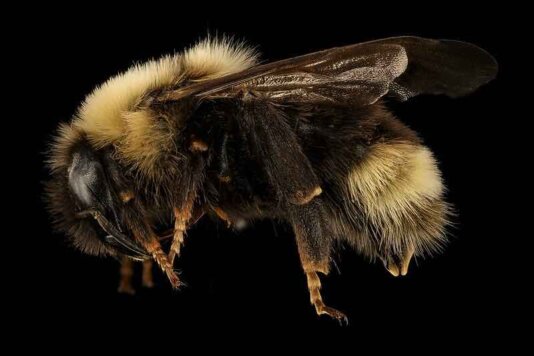- About
- Topics
- Picks
- Audio
- Story
- In-Depth
- Opinion
- News
- Donate
-
Signup for our newsletterOur Editors' Best Picks.Send
Read, Debate: Engage.
| March 30, 2024 | |
|---|---|
| topic: | Conservation |
| tags: | #bees, #save the bees, #Sustainable Agriculture, #food security, #conservation |
| located: | USA, Canada, Slovenia, France, Germany, China, Russia, Morocco, Algeria, Mexico |
| by: | Gerardo Bandera |
Over millions of years, bees have evolved to help them pollinate flowers, even gaining little pollen pouches to carry larger loads. Flowers have also evolved to attract bees and other pollinators and largely depend on them for reproduction.
This is why their disappearance is worrying: over the past century, bee populations have plummeted and some have even been labelled as endangered, leaving their ecosystems - and our food chains - at risk of collapse.
Bees are at risk of extinction largely due to human activities: large-scale changes in land use, industrialised agricultural practices like monocultures, and the detrimental use of pesticides have all contributed to destroying their habitats and reducing their available food sources. Globalisation has also facilitated the transmission of parasites and other invasive species that prey on bees, like the Asian hornet, which can decimate entire hives in hours.
Global warming also plays a large role in the endangerment of the bee population. Rising temperatures, increased flooding, droughts and changes in blooming seasons of flowering plants all affect the bees’ ecosystems, reducing their suitability to the environment and threatening their survival.
While most species of bees have seen wide-scale population loss over the past 300 years, and 40 per cent of invertebrate pollinator species are facing extinction, eight species of bees have officially been declared as endangered.
Seven of the eight are species of the Hawaiian yellow-faced bee, which are at risk due to the threat from non-native species of ants that feed on the eggs, as well as from habitat destruction.
The rusty patched bumblebee (Bombus affinis) is also listed as an endangered species, and faces risk of extinction, most likely due to exposure to pesticides and habitat loss from to urbanisation. The population of the rusty patched bumblebee, which is endemic to North America, has decreased to only 0.1 percent of its historic levels.
Fortunately, not all bees are endangered, although all face serious population decline due to human activity and climate change.
Bees are one of the most efficient and prevalent pollinators. They have a mutualistic symbiotic relationship with flowers and other plants, meaning that both the plant and bee benefit from their interaction. The bees pollinate the plants, spreading the pollen (which they catch on their tiny hairs) from flower to flower, therefore helping the plants reproduce. In exchange, the bees also eat the pollen, which is a critical component of their diets.
The evolution of many flowers has largely been tailored around increasing their attractiveness to bees, favouring flowers who are in the colour spectrum that bees can see (ultraviolet rather than red-hued) and that release a strong, sweet smell when their pollen is ready to take.
But bees pollinate more than just flowers. Many of our favourite fruits and vegetables require the help of bees to pollinate them. From tomatoes, squash, cucumbers and eggplants to nuts, seeds and even cotton.
It is estimated that about 80 per cent of pollination of flowering plants uses the help of pollinators like bees to reproduce. Bees are critical for the stability of our food systems, supporting over 35 per cent of global agricultural land - which is why their disappearance is worrying for humans.
The ecological issue of the possible extinction of the bees is also a humanitarian issue, as the stability of human populations largely depends on the stability of bee populations. Considering the crucial role of bees’ pollination activities in supporting our agricultural systems, their disappearance would likely result in a food crisis for humanity.
Supplies of foods such as apples, berries, avocados, coffee and onions would fall drastically since they require the help of pollinators to reproduce. With plummeting supplies, the prices of these foods would skyrocket, making them rare and inaccessible to most people.
The decimation of these plants would not only impact humans, but also have ripple effects on animals dependent on them for food, leading to broader biodiversity loss.
In order to help us meet the food demand for the world’s rising human population and achieve SDG 2, we must actively protect and foster the populations of bees and other pollinators.
Just as flowers and bees provide mutually beneficial exchanges, humans, all of whom benefit from bees’ pollinating activities, should help foster the health of bees.
World Bee Day (20 May) calls attention to the importance of these beautiful and small creatures, whose activities help preserve and perpetuate life on Earth. The decimation of their populations should remind us of the destabilising nature of human activity, which is possible to prevent and correct.
Our perspectives of our environments and our food chains must shift from focusing solely on the plants we eat to including the other organisms that support plants’ lives - and by extension, our lives as well.
Image by Bianca Ackermann.

By copying the embed code below, you agree to adhere to our republishing guidelines.
